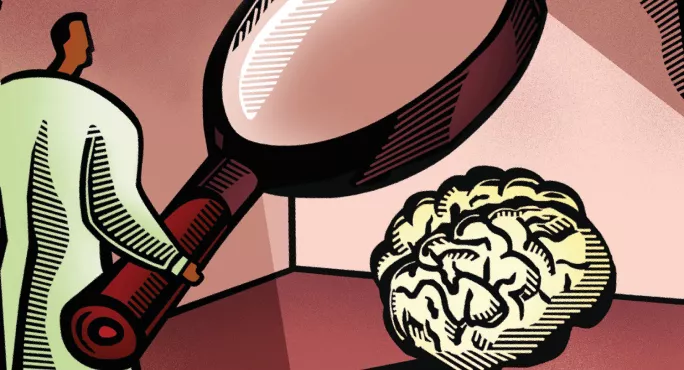
- Home
- Book review: Evolution of the Learning Brain
Book review: Evolution of the Learning Brain

Evolution of the Learning Brain: Or How You Got To Be So Smart…
Author: Paul Howard-Jones
Publisher: Routledge
Info: 248pp, £14.99, paperback
ISBN: 9781138824454
Paul Howard-Jones, professor of neuroscience and education at the University of Bristol,
is possibly best known for his work, along with Sanne Dekker, on the prevalence of “neuromyths” among teachers. It was found, for instance, that in a sample of UK teachers, 91 per cent agreed with the statement that “differences in hemispheric dominance (left brain, right brain) can help explain individual differences amongst learners”.
Perhaps most worryingly, the results showed that belief in neuromyths appeared more common among teachers who had greater general knowledge about the brain.
It seems that a strong interest in, and a little knowledge of, the neuroscience of learning provides little protection against some of the myths teachers often encounter.
In Evolution of the Learning Brain, Howard-Jones provides an accessible introduction to the evolution of the nervous system and brain - hoping, perhaps, to provide readers with a more accurate model of how the brain learns. Channelling the spirit of David Attenborough, he leads us through an evolutionary history of life on Earth, dropping into the timeline at various points to talk about what is happening to the brain and nervous system. There are some genuinely fascinating examples: how E coli possess a simple “memory” based on chemistry that helps it find nutrients; how jellyfish can swim despite not having a brain; and that the “tripartite” model of a vertebrate brain - which emerged some 500 million years ago in jawless fish - has remained remarkably stable over time, providing the model for the brains of amphibians, reptiles, birds, mammals and, of course, human beings.
For evolutionary scientists, the question of “how we got to be so smart” is an important one. The brain is an exceptionally expensive bit of kit: per kilogram, it requires eight to 10 times more energy than the equivalent mass of muscle. Our oversized brains have long been an evolutionary puzzle. Howard-Jones focuses on how the complexity of our social groups and cooperation, and our increasing cognitive flexibility, supported the eventual development of useful tricks such as tool use, language, simple numeracy and the ability to teach others these tricks.
Testing ideas about learning
From here, he charts the emergence of writing and number systems, explaining briefly how our brains support such abilities. For example, reading involves a complex interplay involving the processing of visual information that is then translated into the sounds that comprise words, which are further translated into meaning. In doing so, he tackles a variety of myths: why research into brain lateralisation has led to the myth that people are left-brained or right-brained, and the myth that the direction of a child’s development is somehow “fixed” by about three years of age. He also addresses the allure of “brain-based” explanations - the idea that giving irrelevant neuroscience alongside explanations of psychological phenomena makes such explanations more attractive or plausible. These provide great examples of how neuroscience can help test ideas about learning - and Howard-Jones explains each case with simplicity and clarity.
However, as he explores more direct applications to education, I started to become a bit frustrated with the book. For example, when examining the question of whether stress is a good or bad thing for learning, Howard-Jones tells us about glucocorticoids and noradrenaline, invoking the amygdala and the hippocampus, though the conclusions drawn from this neurobiology appeared in many cases merely to confirm things that we’ve known for a long time; Robert Yerkes and John Dodson suggested that mild stress was beneficial for performance back in 1908.
The book repeats this approach for other findings of behavioural sciences, such as spaced learning (described by Spitzer in the 1930s) and the testing effect (Gates, 1917). In parts, I wondered whether this neurobiological approach is genuinely adding anything to the understanding generated from behavioural psychology, or whether it needlessly shrouds well-supported behavioural observations in unnecessary neuroscience.
The final chapter offers some speculation regarding the future of our evolution and brain development. Howard-Jones offers four alternative visions - not all of them positive - and ends by expressing the future potential afforded by mobile devices that could monitor the neural activity of children learning in the classroom. I wonder whether this really is the great hope for education. While neuroscience has an undoubtedly important role in testing and refining cognitive-behavioural models of learning, I remain to be convinced - despite Howard-Jones’ excellent and very accessible efforts - that it provides the right level of description to be of direct, practical applicability to the classroom.
Nick Rose is design lead at the Institute for Teaching
Register with Tes and you can read five free articles every month, plus you'll have access to our range of award-winning newsletters.
Keep reading for just £4.90 per month
You've reached your limit of free articles this month. Subscribe for £4.90 per month for three months and get:
- Unlimited access to all Tes magazine content
- Exclusive subscriber-only stories
- Award-winning email newsletters
You've reached your limit of free articles this month. Subscribe for £4.90 per month for three months and get:
- Unlimited access to all Tes magazine content
- Exclusive subscriber-only stories
- Award-winning email newsletters



